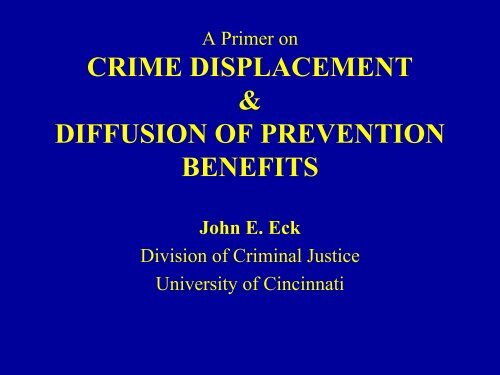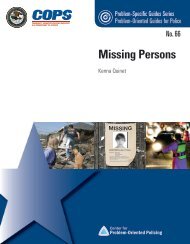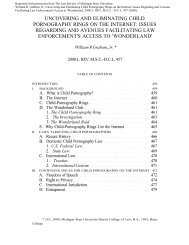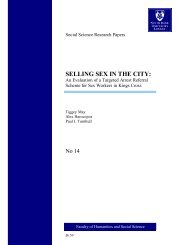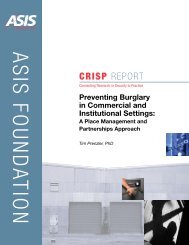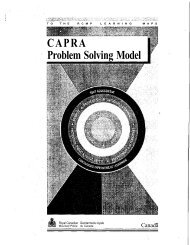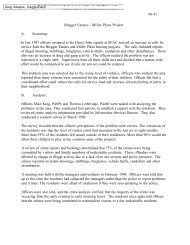CRIME DISPLACEMENT & DIFFUSION OF PREVENTION BENEFITS
CRIME DISPLACEMENT & DIFFUSION OF PREVENTION BENEFITS
CRIME DISPLACEMENT & DIFFUSION OF PREVENTION BENEFITS
Create successful ePaper yourself
Turn your PDF publications into a flip-book with our unique Google optimized e-Paper software.
A Primer on<br />
<strong>CRIME</strong> <strong>DISPLACEMENT</strong><br />
&<br />
<strong>DIFFUSION</strong> <strong>OF</strong> <strong>PREVENTION</strong><br />
<strong>BENEFITS</strong><br />
John E. Eck<br />
Division of Criminal Justice<br />
University of Cincinnati
Oh *#@%!<br />
<strong>DISPLACEMENT</strong>!<br />
GIVE UP!<br />
Overview<br />
1. Questions<br />
2. Myth<br />
3. Theory<br />
4. Evidence<br />
5. Prediction<br />
6. Evaluation
BASIC QUESTIONS<br />
• If we intervene at a place, what keeps<br />
offenders from moving to other places?<br />
• If offenders have propensity to offend,<br />
then won’t they keep offending?<br />
• Don’t we see offenders adapting to<br />
enforcement?
ORIGINS <strong>OF</strong> <strong>DISPLACEMENT</strong> MYTHS<br />
• Sociological & Psychological theories claim<br />
offenders are compelled to commit crimes<br />
• Practitioners often have limited, if not<br />
pessimistic, expectations<br />
• Liberal-conservative alliance<br />
– Only deep societal changes matter (liberal)<br />
– Only offender removal matters (conservative)
POPPING THE MYTHS<br />
• Evidence lacking on utility of societal changes or<br />
offender removal!<br />
• Myth ignores choices made by possible offenders<br />
• Myth ignores laziness, ignorance, and over<br />
emphasizes compulsion<br />
• Myth ignores evidence about displacement itself<br />
• Myth cannot account for diffusion of benefits
MYTH CANNOT EXPLAIN…<br />
• Why crime can decline.<br />
• Short term fluctuations in crime.<br />
• Stability of hot spots and cold spots.<br />
• Why offenders do not displace in advance<br />
of interventions.<br />
• Why offenders spend so much time not<br />
offending.
THEORY<br />
• Displacement and Diffusion<br />
• Types<br />
• Choices and familiarity
THEORY – Adaptation<br />
• People make choices<br />
– Ignorance and uncertainty<br />
– Limited energy<br />
– Malleable perceptions<br />
• Seek easy, familiar, and understood risk<br />
• Avoid difficult, unfamiliar & uncertain<br />
• Desistance – complete cessation<br />
• Deterrence – partial cessation<br />
• Diffusion of Crime Prevention Benefits – added<br />
curtailment<br />
• Displacement – shifting
THEORY - forms<br />
• Spatial – geographic shift<br />
• Temporal – time shift<br />
• Method – procedural change<br />
• Target – target switch<br />
• Crime Type –form switch<br />
• Perpetrator (?) – offender replacement
THEORY - familiarity<br />
• If offenders will displace,<br />
• Then they will displace to<br />
– Places, Times, Methods, Targets, & Types<br />
• That are most like the old ones<br />
• Unfamiliar has greater uncertainty for<br />
– Risk, Reward, and Effort<br />
• If non-crime is more familiar then little or<br />
no displacement
MEASURING <strong>DISPLACEMENT</strong> & <strong>DIFFUSION</strong><br />
Before<br />
Response<br />
Area<br />
Comparison<br />
Area<br />
After<br />
>100% 100% 0%
EVIDENCE<br />
• Multiple reviews of displacement<br />
literature in the 1990s –<br />
• Never 100%<br />
• Often no displacement detected<br />
• If displacement, prevention still effective<br />
• Evidence for Diffusion
Some Criminals Always Displace, all the time.<br />
Freddy<br />
Kruger<br />
The Penguin<br />
Cruella<br />
de Vil<br />
Dracula<br />
Cruella<br />
Deville<br />
Professor<br />
Moriarty<br />
T-X<br />
Lex<br />
Luthor<br />
Wicked Witch of the West<br />
But most don’t!
PREDICTION<br />
• If displacement is to most familiar, then<br />
• Knowledge of offenders could allow<br />
prediction.<br />
• Displacement to existing crime locations.<br />
• Most similar crime types, targets, and<br />
methods.<br />
• Build this into planning the response.
Some (reasonable?) Speculations<br />
• Offenders will waiting for crackdowns to<br />
end rather than displace<br />
• Method displacement more likely than<br />
other types<br />
• Opportunity blocking may have more<br />
diffusion and less displacement than<br />
enforcement<br />
• Diffusion can be increased by increasing<br />
uncertainty of response scope
EVALUATION<br />
• Displacement or Diffusion can<br />
contaminate comparison area<br />
• If displacement, response will look more<br />
effective than it really is<br />
• If diffusion, response will look less<br />
effective than it really is
EXPLANATION FOR<br />
CONTAMINATION EFFECTS<br />
C<br />
R<br />
Area getting<br />
the response<br />
Crime displacing into C makes C get<br />
worse, relative to R.<br />
Prevention diffusion into C makes C<br />
improve relative to R.<br />
Comparison<br />
area
PREVENTING CONTAMINATION<br />
D<br />
Area getting<br />
the response<br />
R<br />
Spatial<br />
displacement/<br />
diffusion area<br />
Preferable<br />
control area<br />
C
CONCLUSIONS<br />
• The inevitability of displacement is a myth<br />
• Diffusion of benefits possible<br />
• Can to plan for and prevent some<br />
displacement<br />
• Need to account for displacement & diffusion<br />
in evaluations
Oh Great<br />
The End


